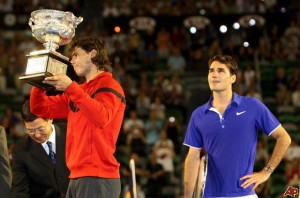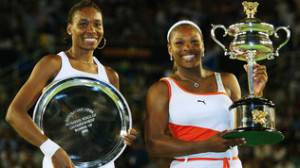Australian Open Goes Back in Time

Much has happened since Rafael Nadal defeated a tearful Roger Federer in the 2009 Australian Open Final.
If you didn’t know better, you might think the Australian Open being shown these days on ESPN was a replay from 2007, not the 2017 version. With Venus and Serena Williams set to meet in the women’s final and Roger Federer facing Rafael Nadal in the men’s final, the tournament definitely feels like Old-Timers Day.
It is hard to say which performance is the most surprising.
Given her constant physical battle with Sjögrens Syndrome, you can perhaps give the nod for most impressive performance to Venus Williams. Though she did not have to face any of the top women’s players in the draw during her run to the finals, it is still impressive that the 36-year-old Venus is back in a Grand Slam final for the first time since 2009 and the first at a tournament other than Wimbledon since reaching the Australian Open final in 2003.
The only performance so far during the Australian Open that isn’t much of a surprise is that of second seed Serena Williams. Shooting for her 23rd Grand Slam title and seventh Australian Open crown, Serena has again been dominant and will be facing her older sister in a grand slam final for the ninth time.
Serena has claimed six of the previous eight finals matchups, including a three-set victory in the 2003 Australian Open. The last time the two met in a Grand Slam Final was the 2009 Wimbledon final when Serena won in straight sets.

It is hard to believe that Venus and Serena Williams will be meeting in the 2017 Australian Open Final 14 years after facing off in the 2003 final.
While sentiment is with Venus, if she is able to overcome her sister for the Australian Open title it would be an upset for the ages.
On the men’s side, the return of both Roger Federer and Rafael Nadal to the men’s final is another huge surprise.
Part of the surprise is because in recent years the men’s tennis world has moved from being dominated by Federer and Nadal to being the domain of Novak Djokovic and Andy Murray. Add to that the fact that both players have battled injuries in recent years and it seemed highly unlikely that they would be meeting for the Australian crown for the first time since 2009.
However, Federer, Nadal and the others in the men’s draw received a surprising present when first Djokovic and then Murray fell victim to upsets.
Though Federer had reached the semifinals in both the Grand Slam Tournaments (Australian and Wimbledon) in which he played in 2016, the fact that he missed the last half of 2016 meant he fell out of the top 10 for the first time since 2002 and was ranked 17th heading in the Australian Open.
His lower ranking meant that he had a slightly tougher road this time around. However, after playing four sets in his first match, Federer won his next three matches in straight sets to reach the quarterfinals.
He then dispatched of fifth seed Kei Nishikor and then fourth seed Stan Wawrinka in consecutive five set matches to reach the Australian Open finals for the first time since 2010.
Given that he had not advanced past a Grand Slam quarterfinal since winning the 2014 French Open, the fact that Nadal is in the Australian Open final might be even more of a surprise than seeing Federer.
Though ranked ninth, Nadal had to rally from a 2-1 set deficit to defeat 24th seed Alexander Zverev in the Round of 32. He then needed five sets to dispatch 15th seed Grigor Dimitrov in the semifinals.
This will be the ninth time that Federer and Nadal have met in a Grand Slam Final with Nadal holding a 6-2 advantage. However, the last time they faced off for a Grand Slam crown was the 2011 French Open.
Nadal is shooting for his 15th major title and to become only the third player, and first in the open era, to win each major title twice.
Federer is aiming to grow his record for Grand Slam titles to 18 and to hoist the Australian Open Trophy for the fifth time.
While history might give Nadal a slight edge, the fact that Federer has an additional day of rest and has actually looked a bit sharper throughout the tournament might tilt the advantage slightly to 35-year-old Federer.
Regardless of who comes out on top in either final, it is clear that age and longtime tennis fans are the biggest winners.
Thanks for the great article 🙂
It was a good read!!